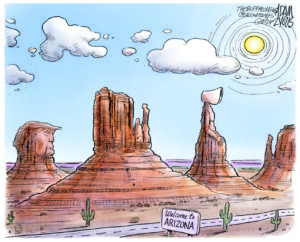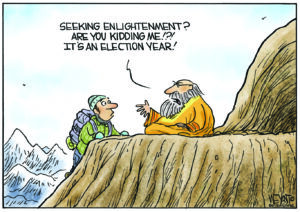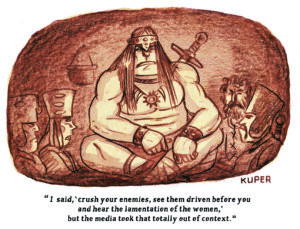The Seventh Exclusion: Key Moments in Racist U.S. Immigration History
At least six other times in the past, people were excluded from America on the basis of race or religion. The Roberts Supreme Court has just legitimized the seventh. Screen shot / YouTube
Screen shot / YouTube
I had predicted, after Donald Trump’s announcement that he wanted to try to keep Muslims out of the United States, that he might well have some success in that endeavor. Courts, as SCOTUS just showed once again, are reluctant to micro-manage the executive branch on things like who can enter the country. Non-U.S. citizens don’t have a constitutional right to visit the United States, so in principle the president can keep some people out, especially if the State Department cooperates in declaring a security threat. In other words, Rudy Giuliani may be as loony as the Mad Hatter, but he knew exactly how to get Trump the racist Muslim ban he wanted and make it stick in the U.S. system.
Ironically, the court decision came back the same day as Alexandria Ocasio-Cortez’s upset win in the 14th Congressional District in New York. The 19th-century, Protestant, Know-Nothing conspiracy would have tried to exclude her from the U.S. for being of Catholic heritage.
The travel ban upheld by a narrow majority on the Supreme Court causes untold heartache to Iranian-Americans, Yemeni-Americans and other groups designated for exclusion. It also injures the First Amendment of the Constitution, which forbids the state to take a position on good and bad religion. It was a sad day when the full court did not agree with the federal court in Hawaii, which made cogent arguments for the policy having originated in an intention to discriminate on the basis of religion, which is unconstitutional. It has nothing to do with security—the nationalities banned haven’t engaged in terrorism on U.S. soil in this century. Most terrorism in the U.S. is committed by white nationalists (many of whom support Trump).
U.S. history is replete with racism as public policy. It has been more often our history than not, and the era since 1965 has been unusual inasmuch as there has been widespread public pushback against the use of race for policy purposes. Trump’s movement is an attempt to see whether that widespread U.S. consensus of the past few decades can be reversed. Just as the Ku Klux Klan took over the Democratic Party in the 1920s, including the whole state of Indiana, so white nationalism has taken over the Republican Party today, including the GOP majority on SCOTUS.
As I have argued in the past, there have been at least six major times in American history when people were excluded on the basis of race or religion (religion is tied up with race in the racialist imaginary).
Here is my list, to which the Roberts court has just added our seventh:
1. Chinese Buddhists: Both racism and religious bigotry built up toward Chinese-Americans brought in from 1849 to build the trans-American railroad. In 1882, Congress passed the Chinese Exclusion Act, the first time a whole people was excluded from the United States. In the prejudiced language of the day, that Chinese were Buddhists, Confucianists or Taoists, i.e., “pagans” or “heathens” from an evangelical point of view, was one of the reasons they should be kept out of the country. The total exclusion lasted until 1943, when 100 Chinese a year began being admitted, which was not much different from total exclusion. In 1965, the Immigration Act ended racial and religious exclusions based on racism and religious fanaticism, including of Chinese. Chinese-Americans have made enormous contributions to the United States, despite the long decades during which they were excluded or disrespected.
2. Japanese Buddhists: In 1907-08, the U.S. and Japan concluded a “gentlemen’s agreement” whereby Japan would limit the number of passports it issued to Japanese wanting to come to the United States. In turn, the city of San Francisco agreed to end the legal segregation of Japanese-Americans in that city (yes, they had their very own Jim Crow). Not satisfied with the agreement, in 1924, racist congressmen ended Japanese immigration completely. This action angered Japan and set the two countries on a path of enmity.
3. Indian Hindus, Sikhs and other Asians: Not satisfied with measures against Buddhists, white Christians next went after Hindus and Sikhs. The 1917, the Asiatic Barred Zone Act excluded from immigration everyone from the continent of Asia—it especially aimed at Indians, especially Sikhs, but also included Koreans, Vietnamese, Thais, Indonesians, etc. The provision in the act barring “polygamists” was aimed at Muslims. Would-be Muslim immigrants were asked at their port of entry if they believed a man could have more than one wife, and if they said yes, were turned away. Japanese were not part of the act only because the above-mentioned gentlemen’s agreement already mostly excluded them. Filipinos were not excluded because the Philippines were then an American territory (i.e., colony).
4. Syrian-Lebanese: In the early 1920s, the Ku Klux Klan reappeared on the national stage and agitated against immigrants, Catholics and Jews. The Klan infiltrated the Democratic Party, took it over and won the whole state of Indiana. The racist 1924 Immigration Act set country quotas based on the percentage of Americans from that country already present in 1890. One consequence of basing the quotas on 1890 rather than, as was originally proposed, 1910, was that populations that came in big numbers during the Great Migration of 1880-1924 were often given low quotas. Populations that came in the 18th century or the mid 19th (in the latter case, Germans) had relatively large quotas. Syria-Lebanon (which were not separated until the French conquest of 1920) were given a quota of 100, even though tens of thousands of Lebanese came to the United States, 10 percent of them Muslim, during the Great Migration. That community produced the great Lebanese-American writer and artist, Kahlil Gibran.
5. Other Middle Easterners, including Armenians: The 1924 Nazi-style quotas based on “race,” which mostly lasted until 1965, excluded most of the Middle East. The quota for Egypt? One hundred. Palestine? One hundred. Turkey? One hundred. Even the persecuted Armenians were given only 100 spaces annually. The racial hierarchies visible in the 1924 act fed into an increasing concern with eugenics, with fears of decadent races and a determination to strengthen the master race by forbidding intermarriage and even by experimenting on live human beings.
6. Jews: In the 1930s, when it would have mattered, the U.S. government excluded Jewish refugees from Nazi Germany from coming to America. As I wrote elsewhere, “The U.S. in the 1930s did betray its ideals as a refuge for people yearning to be free. The episode of the SS St. Louis, a ship full of 900 Jewish refugees that got close enough to Miami to see its lights before being turned back to Europe, epitomized this failure. A third of the passengers were later murdered by the Nazis. One Jewish refugee the U.S. did take in was Albert Einstein. How would we not have been better off if we’d had more like him?” Racists of that time argued that German Jews shouldn’t be admitted because Nazi agents might covertly exist among them.
The only way to undo Trump’s Muslim ban, and to begin to undo the untold damage he’s done to the country, is to organize and canvass and publish and elect the opposition in 2018 and 2020. The courts are not going to save us from Trumpism. The GOP Congress is not going to save us from Trumpism. Civility is not going to save us from Trumpism. We’re on our own, friends. Alexandria Ocasio-Cortez has shown the way.
Your support matters…
Independent journalism is under threat and overshadowed by heavily funded mainstream media.
You can help level the playing field. Become a member.
Your tax-deductible contribution keeps us digging beneath the headlines to give you thought-provoking, investigative reporting and analysis that unearths what's really happening- without compromise.
Give today to support our courageous, independent journalists.









You need to be a supporter to comment.
There are currently no responses to this article.
Be the first to respond.